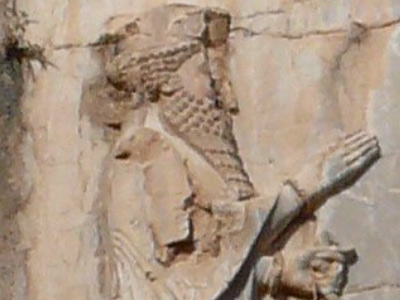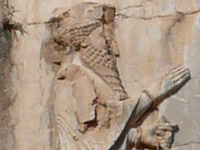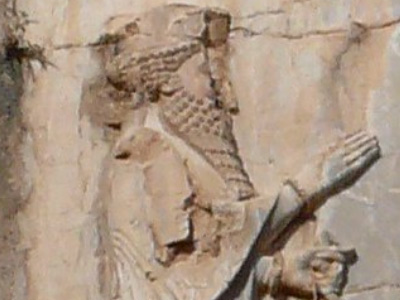Battle of Artemisium (480 BC)

Background
The Greek city-states of Athens and Eretria had supported the unsuccessful Ionian Revolt against the Persian Empire of Darius I in 499-494 BC. The Persian Empire was still relatively young, and prone to revolts amongst its subject peoples. Moreover, Darius was an usurper, and had spent considerable time extinguishing revolts against his rule. The Ionian revolt threatened the integrity of his empire, and Darius thus vowed to punish those involved (especially those not already part of the empire). Darius also saw the opportunity to expand his empire into the fractious world of Ancient Greece. A preliminary expedition under Mardonius in 492 BC, to secure the land approaches to Greece, re-conquered Thrace, and forced Macedon to become a fully subordinate client kingdom part of Persia. It had been made a vassal or ally as early as the late 6th century BC, but remained having autonomy. Mardonius' campaign of 492 BC changed this.
In 491 BC, Darius sent emissaries to all the Greek city-states, asking for a gift of 'earth and water' in token of their submission to him. Having had a demonstration of his power the previous year, the majority of Greek cities duly obliged. In Athens, however, the ambassadors were put on trial and then executed by throwing them in a pit; in Sparta, they were simply thrown down a well. This meant that Sparta was also effectively at war with Persia.
Darius thus put together an amphibious task force under Datis and Artaphernes in 490 BC, which attacked Naxos, before receiving the submission of the other Cycladic Islands. The task force then moved on Eretria, which it besieged and destroyed. Finally, it moved to attack Athens, landing at the bay of Marathon, where it was met by a heavily outnumbered Athenian army. At the ensuing Battle of Marathon, the Athenians won a remarkable victory, which resulted in the withdrawal of the Persian army to Asia.
Darius therefore began raising a huge new army with which he meant to completely subjugate Greece; however, in 486 BC, his Egyptian subjects revolted, indefinitely postponing any Greek expedition. Darius then died whilst preparing to march on Egypt, and the throne of Persia passed to his son Xerxes I. Xerxes crushed the Egyptian revolt, and very quickly restarted the preparations for the invasion of Greece. Since this was to be a full-scale invasion, it required long-term planning, stock-piling and conscription. Xerxes decided that the Hellespont would be bridged to allow his army to cross to Europe, and that a canal should be dug across the isthmus of Mount Athos (rounding which headland, a Persian fleet had been destroyed in 492 BC). These were both feats of exceptional ambition, which would have been beyond any contemporary state. By early 480 BC, the preparations were complete, and the army Xerxes had mustered at Sardis marched towards Europe, crossing the Hellespont on two pontoon bridges.
The Athenians had also been preparing for war with the Persians since the mid-480s BC, and in 482 BC the decision was taken, under the guidance of the Athenian politician Themistocles, to build a massive fleet of triremes that would be necessary for the Greeks to fight the Persians. However, the Athenians did not have the manpower to fight on land and sea; and therefore combating the Persians would require an alliance of Greek city states. In 481 BC, Xerxes sent ambassadors around Greece asking for earth and water, but making the very deliberate omission of Athens and Sparta. Support thus began to coalesce around these two leading states. A congress of city states met at Corinth in late autumn of 481 BC, and a confederate alliance of Greek city-states was formed. It had the power to send envoys asking for assistance and to dispatch troops from the member states to defensive points after joint consultation. This was remarkable for the disjointed Greek world, especially since many of the city-states in attendance were still technically at war with each other.
The 'congress' met again in the spring of 480 BC. A Thessalian delegation suggested that the allies could muster in the narrow Vale of Tempe, on the borders of Thessaly, and thereby block Xerxes's advance. A force of 10,000 hoplites was dispatched to the Vale of Tempe, through which they believed the Persian army would have to pass. However, once there, they were warned by Alexander I of Macedon that the vale could be bypassed through the Sarantoporo Pass, and that the army of Xerxes was overwhelming, the Greeks retreated. Shortly afterwards, they received the news that Xerxes had crossed the Hellespont.
Themistocles therefore suggested a second strategy to the allies. The route to southern Greece (Boeotia, Attica and the Peloponnesus) would require the army of Xerxes to travel through the very narrow pass of Thermopylae. The pass could easily be blocked by the Greek hoplites, despite the overwhelming numbers of Persians. Furthermore, to prevent the Persians bypassing Thermopylae by sea, the Athenian and allied navies could block the straits of Artemisium. This dual strategy was adopted by the congress. However, the Peloponnesian cities made fall-back plans to defend the Isthmus of Corinth should all else fail, whilst the women and children of Athens were evacuated en masse to the Peloponnesian city of Troezen.
HISTORY

RESOURCES
This article uses material from the Wikipedia article "Battle of Artemisium (480 BC)", which is released under the Creative Commons Attribution-Share-Alike License 3.0.
© Stories Preschool. All Rights Reserved.









